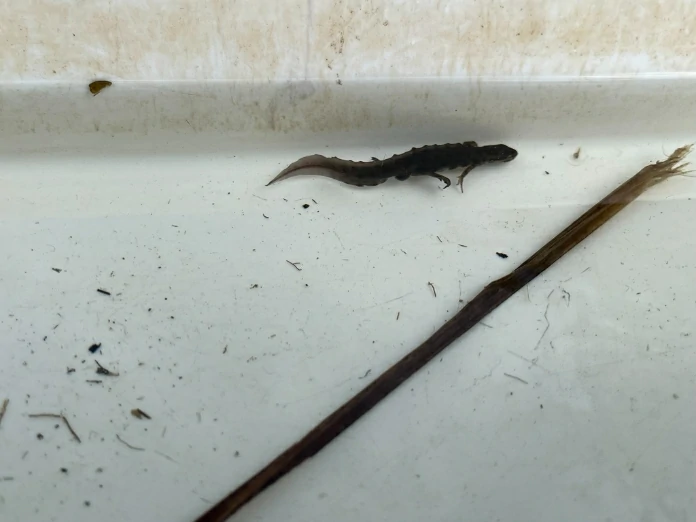Imagine you’re sitting by a quiet pond in the evening, and you spot a newt. You might wonder, are newts really water animals? Or do they just visit ponds from time to time?
Newts are both water and land animals. They spend part of their life in water and part on land. How long they stay in each place changes as they grow, and even with the seasons. They’re not made only for water, but water is always very important for their survival.
A Newt’s Life Starts in Water
Newts start out like many amphibians: as eggs laid in water. A female sticks them to plants, stones, or twigs in ponds and slow-moving streams.
The eggs hatch into tiny larvae that look a bit like tadpoles. At this stage, newts breathe through feathery gills and swim constantly.
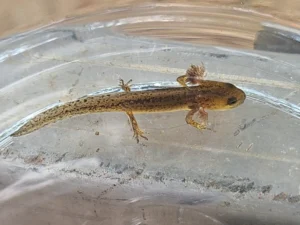
Without water, they wouldn’t survive.
So yes, from the very start, water is home.
When Do Newts Leave the Water?
As the larvae grow, they slowly lose their gills, develop lungs, and their bodies change to get ready for land.
For Eastern newts, this means becoming a red eft.
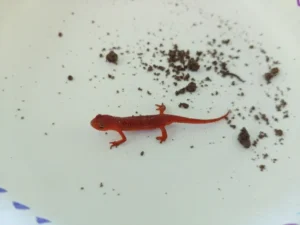
The bright orange-red eft crawls out of the water and spends several years wandering the forest floor.
This is a land-based life, far away from ponds. They hide under logs, in leaf litter, and in damp soil.
So even though newts start in water, they also need time on land to grow up.
Why Do Adult Newts Go Back to Water?
When newts become adults, something interesting happens, they go back to the water.
Their skin becomes smoother, their tails flatten for swimming, and they start searching for mates.
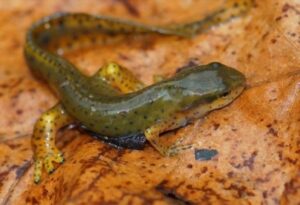
Water becomes the center of their lives again. Adults feed, mate, and spend most of their time in ponds or quiet wetlands.
So while the young eft stage is land-based, adulthood draws them back to the water that first nurtured them.
Do Newts Stay in Water All Year?
Not always. Many adults spend spring and summer in ponds, where breeding happens and food is easy to find.
But when cold weather comes, some hide in soil, under logs, or in damp spots on land.
Others may stay underwater, slowing down and waiting out the winter. It depends on the climate and the species.
So while water is always important, it’s not the only place they can survive.
Why Water Matters Even on Land
Even when they’re on land, newts are never far from moisture. Their skin needs to stay damp to breathe properly, because part of their oxygen comes through their skin.
That’s why you’ll often see them in forests, meadows, or gardens after rain. Even away from ponds, water in the environment is very important for them to survive.
Do All Species of Newts Follow the Same Pattern?
Not exactly. Different species spend different amounts of time on land and water:
-
Eastern newt (North America): starts in water, lives years on land as a red eft, then returns to water as an adult.
-
Smooth newt (Europe): adults spend breeding season in water but move onto land at other times.
-
Japanese fire belly newt: more aquatic, with adults spending most of their lives in ponds or streams.
This shows that while all newts depend on water, some are more tied to it than others.
How Ponds Shape Newt Behavior
If you watch a pond closely in spring, you might notice newts gliding through the water, sometimes doing graceful courtship dances.
Males often fan their tails or show bright spots to attract females.
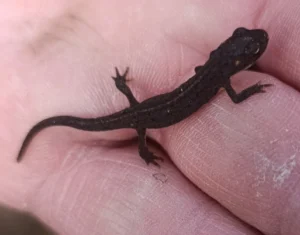
These displays only happen in water. Without ponds, breeding wouldn’t be possible.
That’s why wetland habitats are so closely tied to newt populations.
Do Newts Ever Leave Water Forever?
No, not permanently. Even species that spend a lot of time on land still go back to water to breed. If a pond or wetland disappears, the local newts will often decline or vanish.
This is why protecting their habitat is very important. Without water, newts can’t complete their life cycle.
Why People Think Newts Are “Water Animals”
Newts are often seen swimming or resting in ponds, which makes it seem like they live only in water. Many pictures and videos show them underwater.
But that’s only part of the story. They may look like fish at times, but their connection to land is just as strong.
It’s better to think of them as animals that live in both worlds.
Are Newts More Aquatic Than Salamanders?
Here’s a related question: are newts more tied to water than other salamanders?
Usually, yes. Many salamanders, like tiger salamanders, spend most of their adult lives underground or on land, going to ponds only to breed.
Newts, on the other hand, often stay in water longer as adults, and some barely leave it. This is one thing that sets them apart from other salamanders.
What Happens If Newts Lose Their Water Homes?
Sadly, many newt populations are in trouble when wetlands are drained or ponds are polluted. They lose the heart of their survival.
In some areas, people have made artificial ponds to bring them back. Garden ponds, made safely without harmful fish, can even give newts a new home.
This shows how tied newts are to water, without it, they just can’t thrive.
Conclusion
So, are newts meant to live in water? The answer is both yes and no. They need water for key parts of their lives, as eggs, larvae, and as adults when they breed.
But they also need land, sometimes for years, especially during the red eft stage.
Their lives are all about balance. Not fully fish, not fully land animals, but something in between. Water is central to who they are, but land is part of their journey too.
If you ever see a newt slip into a pond or crawl out onto damp soil, remember this: they are creatures of both worlds, living with the rhythm of water and land in their lives.
Hi, my name is Ezra Mushala, i have been interested animals all my life. I am the main author and editor here at snakeinformer.com.

